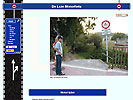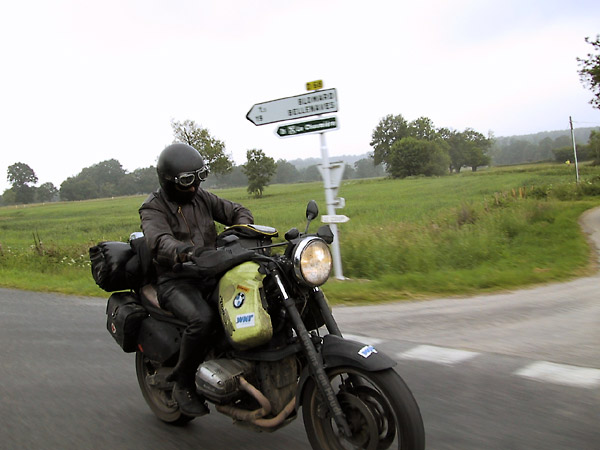
The most important aspect of riding a motorcycle is looking ahead. Being able to look ahead, being able to notice what's important, is a vital element of motorcycle riding.
It would seem that that's something everybody is capable of, but you will notice
that there is much to learn about looking ahead.
You ride towards where you look, so to learn cornering well, you will have to look in the right direction.
On traffic, you will have to learn to notice far more than you usually see.
Whether safety or speed appeals most to you, you will have to work on your looking skills. What's there to see? How can you practise your capabilities? This page tries to formulate an answer.
![]() Er is een Nederlandse versie:
Er is een Nederlandse versie:
http://www.luiemotorfiets.nl/tips/looking/
How do you learn to ride well?
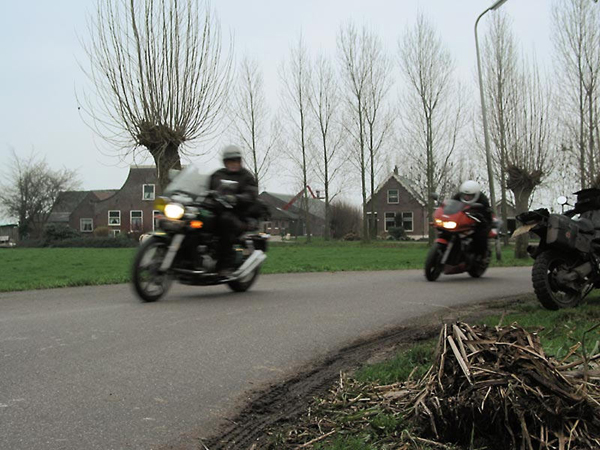
Imagine
The road is just motorcycle heaven.
Two motorcyclists ride there, but they don't notice each other until they meet.
Actually, they meet at the moment that one of them overtakes the other, in a corner.
The overtaking motorcyclist waves his hand after having passed the other, to greet.
"How is that possible?", the other motorcyclist thinks, "My motorcycle is faster and more sporty than his, so he isn't suppose to be able to pass me, is he?"
Well, how comes? It is not always the case that the fastest bike is the fastest one in corners.
Is the overtaker just totally irresponsible, and was it only a matter of luck that he didn't finish against a tree? Possible, but not probable.
Did the overtaker just ride more miles than the one who is being passed? It could be the case, but not necessarily so.
Is it just luck than, being born with the right talents, the right genes? After all it is perfectly possible to be the owner of a fast motorcycle, and having done lots of miles, but still not be a really good motorcyclist.
Keep learning
Riding a motorcycle means that you learn all your life. Everyone learns, after having passed the exam, by means of permanent self-study.
And like in the case of self-study, support can make the difference between gaining slowly, or passing in a corner.
There are a few basic techniques that everybody can train. Some people train them automatically; for others, it gets easier when the techniques are brought to their notice.
Riding technique number one
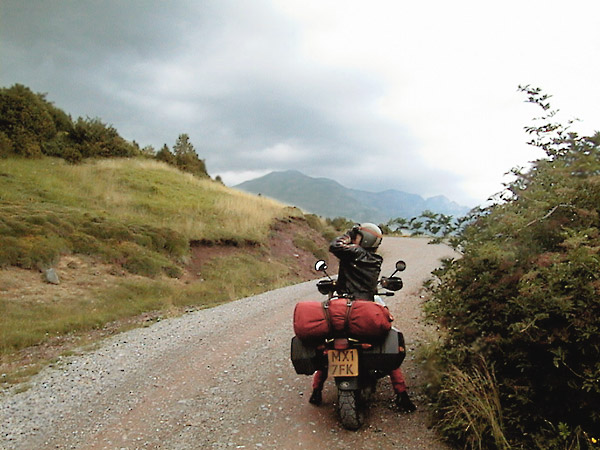
Motorcycle riding is about looking
In the same way that the human body consists of water for more than 90%, riding a motorcycle consists of looking for more than 90%.
You probably heard it many times during your lessons: "Look where you want to go."
The negative implication can be seen when a lonely motorcyclist doesn't feel secure in a corner, and points his motorcycle exactly in the direction of the one lonely tree in the long and clear corner.
During your lessons, you probably learned to look in the direction where you want to go when practising small circles and figures of eight: the farther you look into the circle, the sooner you look to the next cone (or the one after the next, or even one after that one), the easier it is not to make mistakes.
But looking ahead is not only important when riding in small circles. Looking ahead is the basic ingredient of motorcycle riding.
Training
Training your capabilities to look ahead probably is the most effective way to enhance your riding capability.
Visor and glasses
In the first place, make sure that the circumstances are right: a clean visor, sunglasses when the sun shines, yellow glasses in the mist or when it's dark. And always keep your head upright, also when cornering and the bike is inclined.
Looking and traffic: anticipate
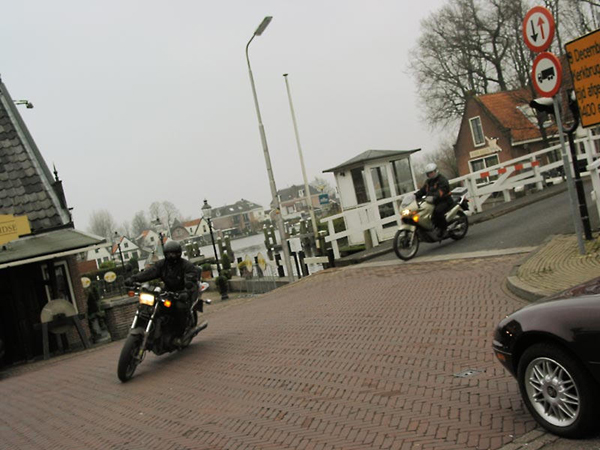
Who's fault it was doesn't matter
Hopefully, every motorcylist knows that keeping to the traffic rules is not enough. You don't gain much when you're dead, of the knowledge that you had the right of way, and when riding a motorcycle, the risk of being hurt in an accident is higher than in a car which takes a lot of an impact.
So the idea is that you are responsible for your own safety, whether the traffic around you behaves as it should or not. That means that you must learn to see which (dangerous) actions the rest of the traffic will take, or which actions people might take.
Predict mistakes
You should have thought long enough in advance of the possibility that the one car that you see coming towards you in a sidestreet, might "forget" that you are the one who has the right of way, and he is the one who should yield.
That car in front of you, decelerating and steering to the right and
blinking his right blinker, could very well decide to steer to
the drive access on the left, exactly at the moment that you are passing him.
It is an often occurring cause of accidents, cars showing that they want
to go to the right, turning to the left at the last moment.
That car driving towards you very well could, exactly at the moment that you ride by, turn to the left.
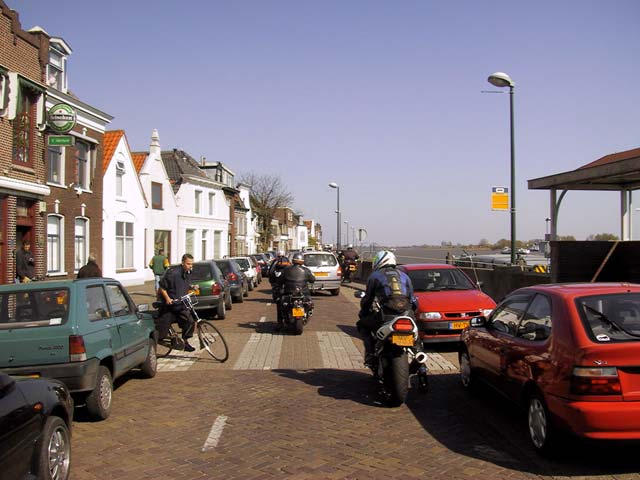
Developing a sixth sense
So you should learn to foresee every crazy action of the rest of the traffic, so that you are prepared.
As you will see, you will develop some sort of a sixth sense for these situations: just before someone hits you by doing something very stupid, you "know" what is going to happen, and you are able to escape from the situation safely.
You will develop a sort of internal list of mistakes that occur often. When somebody makes such a mistake, you will have seen it before he makes the mistake.
The longer you ride, the more kilometers or miles you have ridden, the bigger your list of possible stupid actions gets, and the less often you will be taken in surprise.
Practise on the highway
On the highway, you can train yourself in looking by checking whether you had "foreseen" everyone who passes you. If that happens without having foreseen it, you should have checked your mirrors more often, or you should have been better in calculating and remembering. (The best country to practice, is of course Germany ;-)
Off the highway you practice by telling yourself everything you notice.
And here too: actions that you didn't foresee mean that you should get better in looking and thinking.
Know what you cannot see: anticipate
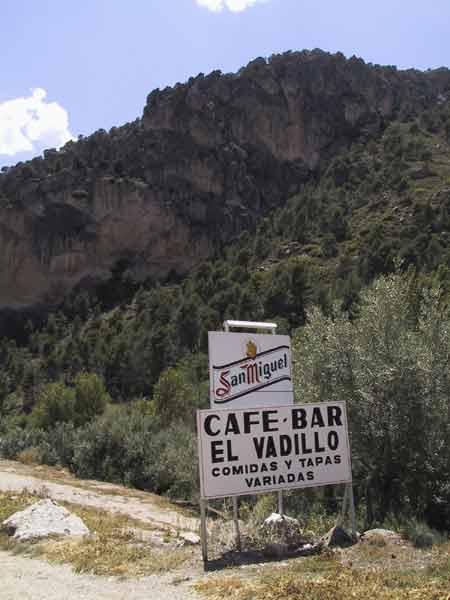
It might seem impossible, to be able to foresee every stupid mistake of everybody around you, but even when you are able to do so, that's not enough!
Hidden danger
Except foreseeing mistakes of everybody you see, you must also foresee mistakes of everybody you don't see.
That van that's parked over there: every moment a ball may roll from behind the van, followed by a child.
That tractor driving towards you, could hide an invisible, hasty car, that could overtake the tractor without noticing you.
A sign for a bar at the side of the road? That means a drive access, so somebody can come out of it, or somebody around the corner could stand still to drive into the drive access.
Every obstacle blocking your view can hide a moving object (vehicle or person or animal).
Friday evening
A totally different kind of non-visisble danger is for instance the knowledge that
it is friday evening: lots of people had a company-drink (unbelievable that these are
still being organized: the more lease-cars, the more company-drinks), and later on
there are the people coming from cafe's.
In France, you have to be extra alert, for the same reason, after every meal.
Drunken drivers often show velocities that vary enormously, and when they sway you
can be certain about what's going on.
During your riding career you will develop a list of "suspected situations".
In case you cannot be seen
Remember that, the other way around, there are many situations in which you form a non-visible danger for others, for instance when you pass a truck when approaching a crossing.
There is a really brillant English movie showing some of the many situations that you will have to learn.
Practise by telling yourself
You can practise by telling yourself, during a trip, everything that might lead to
possible danger. Concentrate on one aspect at a time, so don't try, at the same time, to
increase your speed in corners for instance.
The more often you practise, the more you will notice these things automatically.
The road
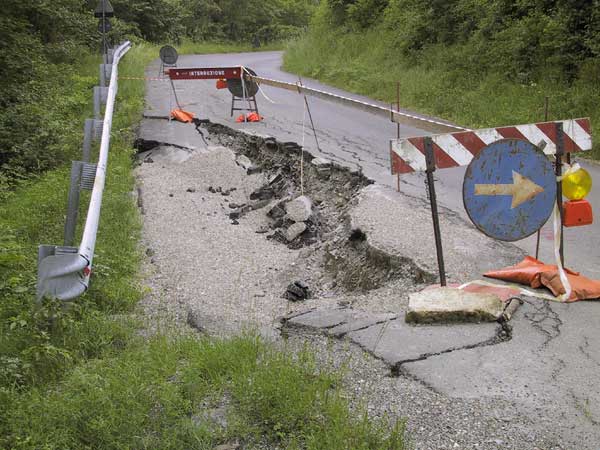
The road may speak to you
The road itself can tell you lots of things. At the moment that the road suddenly is gone, you realise how much you trust a road to "behave" as you expect it to do.
Objects such as trees or telephonepoles may predict the route your road will take (but not always!).
Most of the time, irregularities in the side of the road means there is a drive access or a side road.
White lines
White markings on the road help you (most of the time you even don't notice how much)
to see the route of the road. You will notice when there are no markings!
Interrupted white lines are put closer onto each other at "difficult" stretches,
and you will automatically slow down on such stretches.
A double uninterrupted lins means that you are riding on a dangerous stretch.
The surface
And then of course, there is the road surface, with grid, black bitumen seals which can be slippery when it's raining, white plastic markings which are also slippery when wet, etc.
Practise looking far ahead
Most of the time, you already study the surface of the road consciously. Practise to remember to look far ahead: when there is grid on the road, people are declined to look just in front of their front wheel, which is unsafe because you will not be prepared for what's going on farther ahead.
Lane splitting

Look far ahead
Split-laning consists mostly of looking ahead as well.
One of the common mistakes is, again, looking too much in front of your front wheel. When you do that, you will probably swerve instead of riding a straight line.
When you keep looking far ahead, you will be perfectly able to ride in a straight line between the cars. That's much more agreeable for the cars you pass.
At certain points, you can expect difficult situations:
Disappearing lane
When one of the lanes disappears further on, you can be certain that many cars
will try to go to the next lane long before. The best thing to do is switch to the
space between the next two lanes.
When you do that, watch out for fellow-motorcyclists!
Fellow motorcyclists
When you decide to split lanes when the traffic around you slows down, you have
to be especially careful: *always* check your mirrors. It happens all too often that
a motorcyclists hears another motorcyclist approaching between the lanes, while he
himself is riding in a lane like the cars, and *then* exactly *then* decides to go splitlaning.
The one behind you has the right of way! When you decide to go splitlaning,
you have to behave in exactly the same way as when you decide to overtake someone:
check your mirrors to look whether it is possible!
The other way around also applies: when you are splitlaing and approach another motorcyclist who rides in a lane between the cars, be very alert! He might decide to ride between the lanes exactly at the moment that you are passing him!
Lane switching of cars
When the traffic jam just developed, there are more changes of lanes then when the traffic jam has "settled".
Near acceleration and deceleration lanes, you have to be extra carefull: there
is much lane switching here. To prevent being surprised by a car switching lanes
just in front of you, or even when you are next to him, You should *not* focus on
the cars just in front of you! Always look far ahead, and focus on *movement*.
You always see a wheel turning just before a lane switch.
Check people's mirrors to check whether they've seen you.
And in some cases, you will even see a blinker before someone switches lanes ;-).
You also often see a car first moving to the other side before turning towards you.
Space between cars
Be extra alert when there is an opening between two cars: the chance that a car in the other lane wants to use that opening is a big one.
Truck
Often, there is a big space before a truck, which you can't see because the truck blocks your view. A car may be hidden before a truck. You can't see its wheels or blinkers, so it might surprise you when you pass the truck!
Doors
When cars in a traffic jam are really stopped, you may expect doors opening: be very careful and slow then, because there is no clue to anticipate suddenly opening doors.
Mirrors
At last: when lane-splitting, keep using your mirrors. When you see somebody behind you, find an opening an let him pass: always ride your own speed, and help others do the same.
Look at yourself
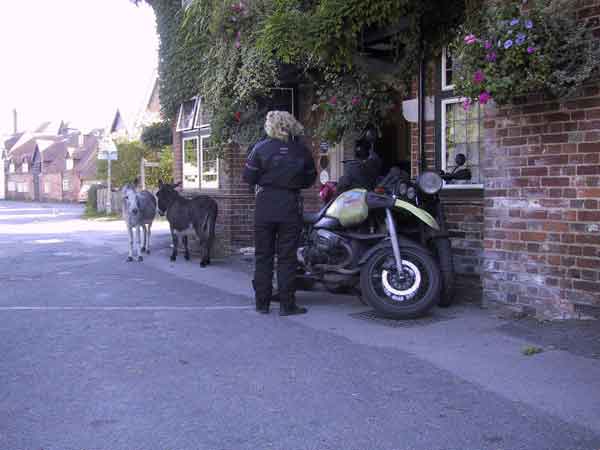
One of the most important aspects of learning how to look, is learning how to look at yourself.
Keep learning
During a trip, you might concentrate on one thing, and registrate what you *could* have seen, but did not. You should treat that as valuable information from which you can learn, and not as negative criticism telling you that you did something wrong.
Look wide
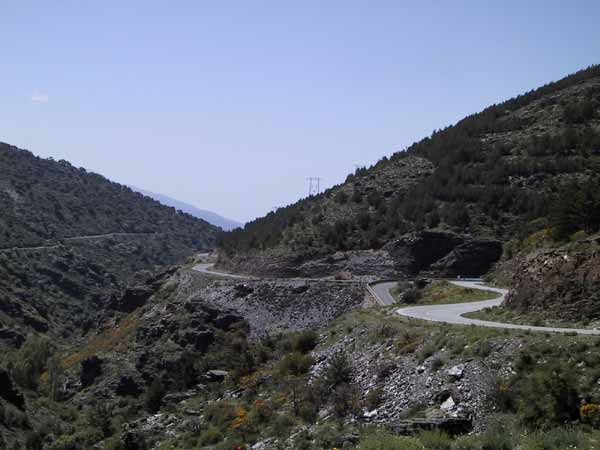
See everything at the same time
Ultimately, you should become able to keep looking "wide" in every circumstance. What that means is that you should *not* concentrate on one object, that you should not only look far ahead or only close by, that you should not only see the road or only what's beside the road, but that you should see everything at the same time, all the time.
Process information
You will observe that the longer you look wide, the more information
can be distilled from what you see. You see something moving, not on the road
but somewhere on your right, a car, a bicycle. So you are prepared for a
side street long before you see the road itself.
You see beets on the land next to the road, and you know it's the time of the
year that the beets are being digged up. So whatch out for slippery muddy roads.
Practise
You can practise looking wide too. Remember that it is never necessary to train yourself to look nearby: you always do that automatically. The problem is in training to look far ahead, end to the sides, and to keep looking like that.
Look, see, understand
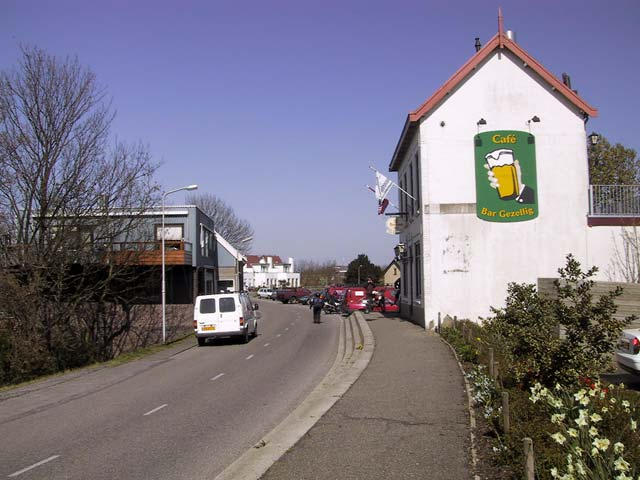
From the eye to the brains
If you want to define looking, you might differentiate between the image that your eyes
transport to your brains (roughly about everything within your field of vision),
what you *see* consciously (much less), and what information you distill from what you
see (the meaning that you give to what youn see).
Your eyes tell your brains: "we see a white surface, with something green and yellow in it."
Your brains think: "Hmmmmm, this might be important: tell the boss!".
And then you realise that it might be a good time to drink a beer.
Remember that after the beer, the "look, see, understand" will be a lot harder to
perform fast enough, so better take an alcohol-free.
It's the brain that counts
So, when learning how to look, it is not necessary to teach your eyes to transport
more signals to your brain: in most cases, everything you need will be there.
The problem lies in what your brain decides is important, and the conclusions that you draw (or not).
So, learning to "look wide" is not only a question of not focusing on one point, but also a question of *seeing* as much as possible: making conscious what your eyes can tell you. You should learn to *see* things that you normally don't notice, because your brain thinks they're unimportant (like many car drivers really didn't *see* the motorcyclist they bumped into) (though their eyes did see him).
The brains of others
The other way around, you should be aware of the fact that many of the vehicle-drivers around you only see what they expect to see, what they're used to see.
A very dangerous situation with that respect is when a car is waiting at
a crossing which is empty. A truck comes by, and in the mean time you
arrive, from the other direction, invisble because of the truck.
The car driver now is strongly inclined only to see what he expects: nothing,
an empty crossing, because that's how the crossing looked the last time he saw it.
So the chance he will not see you is big.
Learn what others don't see
So, at last, learning to look, also means to learn to know what others don't see, and be prepared for the consequences. If you must look over a car to see the next one, he will probably not see you. If you are having trouble spotting somebody in his mirror, he will probably not see you.
Comments, Q & A, on a separate page




